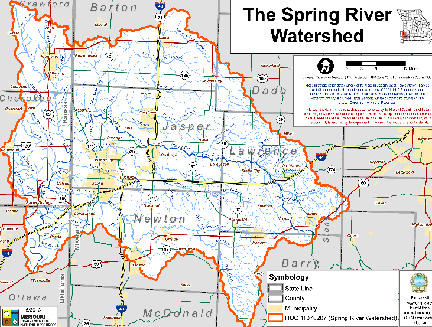
All Spring River Watershed residents are encouraged to attend a meeting sponsored by the Harry S. Truman Coordinating Council (HSTCC) outlining the draft of the Spring River Nonpoint Source Watershed Management Plan that was developed through a collaborative effort of stakeholders during the last two planning sessions held in November 2013 and February 2014. The council will keep the document finalized in January 2015 for future use of planning and coordination opportunities inside the watershed.
The final round of public meetings-four identical sessions--will review specific water quality impairments and sources addressed by the plan, goals for reducing pollution loading, types of agricultural best practices (BMPs) to reduce pollution and priority areas for implementing BMPs in the future. Also shown will be how eroding stream banks, failing septic systems and storm water runoff can best be addressed through best management practices in order to contribute to restoring impaired waters and achieving water quality standards.
The dates and locations of the meetings are:
- October 15 at 6:30 p.m. - Southwest Research Center, 14548 Highway H, Mount Vernon
- October 16 at 1:30 p.m. - Lampo Center, 500 E. Spring St., Neosho and 6:30 p.m. - Barton County Extension Center, 801 E. 12th St. Lamar
- October 17 at 9 a.m. - Carthage Water and Electric community room, 627 W. Centennial, Carthage
What is the Spring River Watershed and why is it important to me?
The Missouri portion of the Spring River watershed covers an area of more than 2,000 square miles and includes the counties of Barry, Barton, Dade, Jasper, Lawrence, and Newton. Communities within the watershed include Carthage, Joplin, Lamar, Monett, Mount Vernon, Neosho, and many others.
A watershed, in which everyone lives, is defined as an area of land that drains to a particular water body like a stream, river, or lake. A healthy watershed is very important as it can help sustain the designated uses for that body of water which vary from recreation to drinking water to supporting a healthy aquatic life. Most significantly, watersheds do not conform to man-made boundaries, so residents from various counties share the important responsibility of protecting and improving their water resources in the watershed.
Funding for the development and support of the Spring River Nonpoint Source Watershed Management Plan is through a Clean Water Act grant provided by the Missouri Department of Natural Resources. For further information contact Timothy Little by sending an e-mail here or by phoning (417) 649-6400.






Comments